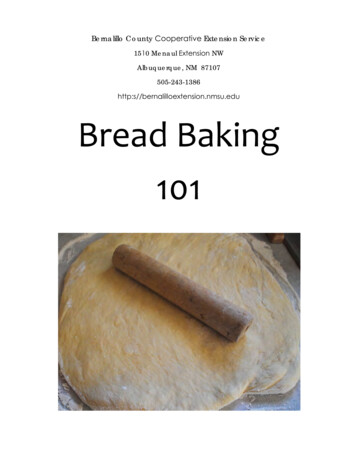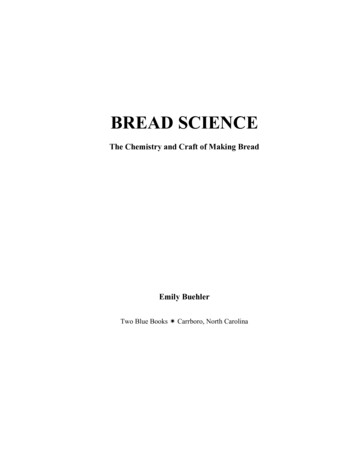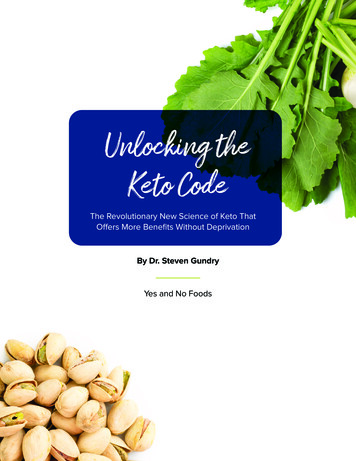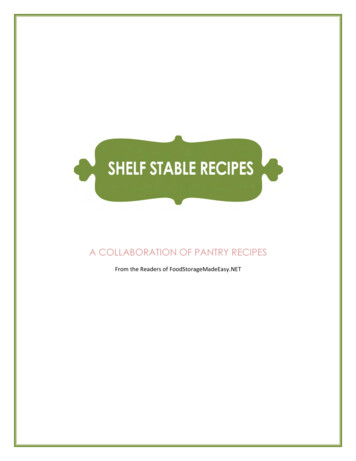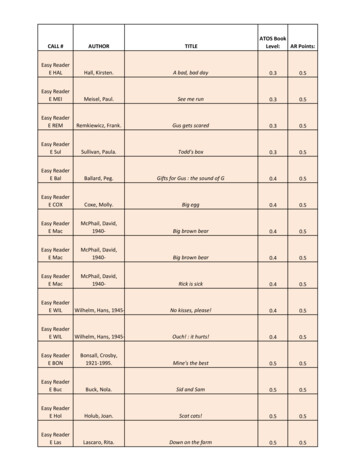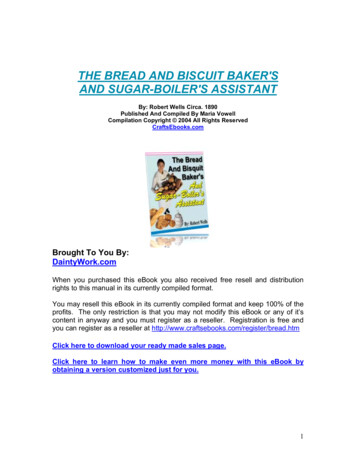
Transcription
THE BREAD AND BISCUIT BAKER'SAND SUGAR-BOILER'S ASSISTANTBy: Robert Wells Circa. 1890Published And Compiled By Maria VowellCompilation Copyright 2004 All Rights ReservedCraftsEbooks.comBrought To You By:DaintyWork.comWhen you purchased this eBook you also received free resell and distributionrights to this manual in its currently compiled format.You may resell this eBook in its currently compiled format and keep 100% of theprofits. The only restriction is that you may not modify this eBook or any of it’scontent in anyway and you must register as a reseller. Registration is free andyou can register as a reseller at k here to download your ready made sales page.Click here to learn how to make even more money with this eBook byobtaining a version customized just for you.1
I hope you enjoy this ebook, and I hope that you have a wonderful time cooking.When you obtained this manual, you also received resell rights where you arefree to resell this manual for whatever price you like, as long as you do notmodify the content in anyway. You are also free to give it away free asincentives to your website visitors, or as a thank you gift to your auctioncustomers.You also get a ready made sales page that you can use to resell this manual,from your website. If you do not have a website already, then I highlyrecommend Host4Profit as a wonderful hosting provider.If you do not know anything about building a website, that’s ok because whenyou become a Host4Profit customer, you also gain access to one of the Internet’sbest forums where you can get help day or night from thousands of otherprofessional website owners.Click here for more information about Host4ProfitI would also like to inform you of another wonderful eBook, “Maximizing YourProfits From Your Craft Sales”. This manual also includes resell rights, andeverything you need to know about maximizing your profits, increasing sales ofyour products and gaining new customers is included in this manual!Click here for more information about “Maximizing Your Profits From YourCraft Sales".Once more I hope you enjoy your recipes, and I hope you have many joy filleddays of cooking in the future.Sincerely,Maria VowellRecommended Resources:Crafts eBooks Providing some of today’s top selling arts and crafts relatedeBooks. Many with resell rights!Cater Your Way To Riches Are you passionate about parties? Do you live tocook? Now you can realize your dream by Starting a Catering Business!Auction Riches Are you looking for an opportunity to make money online? I'mtalking about a REAL opportunity that ANYONE can make money doing!2
TABLE OF CONTENTSBREAD AND BISCUIT BAKING, ETC.I. -- INTRODUCTORY CHAPTER .4Slow Process in the Art of Bread-making Need of Technical Training Chemistryas applied to Bread-making.Process of Fermentation.Liebig on the Process of Bread-making Professors Jago and Graham on BrownBreadII. -- GENERAL REMARKS ON BAKING .11Baking and its several Branches Essentials of good Bread-making German Yeastand Parisian Barm Recipe for American Patent Yeast. Judging between goodand bad Flour Liebig on the Action of Alum in Bread Professor Vaughan onAdulteration with Alum Importance of good Butter to the Pastrycook.RecipesBREAD, TEA CAKES, BUNS, ETC .15GINGERBREAD, PARKINGS, SHORTBREAD, ETC .27HARD BISCUITS 32FANCY BISCUITS, ALMONDS, Etc 38PASTRY, CUSTARDS, ETC 49FRUIT CAKES, BRIDE CAKES, ETC .51HANDY WHOLESALE RECIPES FOR SMALL MASTERS 59The Sugar Boiler’s AssistantCONFECTIONS IN SUGAR-BOlLING 62COLORING SUGAR .73LOZENGES .76ICE CREAMS .77PRESERVING FRUITS .79CHOCOLATE .833
THE BREAD AND BISCUIT BAKER'S ASSISTANTI. INTRODUCTORY CHAPTERWhen we reflect upon the present conditions under which the breadmaking industry is carried on in most of the large cities and towns ofEngland, Scotland, and Ireland, and remember the importance of thatindustry to mankind, we cannot but be impressed by the littleprogress that has been made in the art of bread-making. Whilst otherindustries have been marked by important improvements, we findbread being made in much the same manner as it was five hundredyears ago. The mystery is how -- by accident, it would seem -- Weget such well-made bread as we do. There are very few even nowwho have the slightest conception of what yeast really is, and fewerstill who know how or why it makes bread light. But it will surprise meif the trade does not undergo, in the course of the next ten years, acomplete and beneficial change.Master bakers and confectioners are everywhere complaining of theincompetency of their workmen; and it cannot be denied that there issome ground for the complaint. Proper training in the baking andconfectionery trade is of great importance. A trained servant givessatisfaction to his employer, and receives a responsive good feelingin return.Let us see what is meant by "training." In its broadest and best sense,it is knowing what to do, and when and how to do it.Take the first condition -- What to do. This may be considered on twogrounds, generally known as the practical and the theoretical, thoughthe latter is sometimes confounded with the scientific, and people areled to sneer at science. Much has been said lately in our tradejournals about introducing scientific chemistry to the journeymanbaker in connection with his daily work of making bread. But howmany journeyman bakers could we find that even understand themeaning of the word chemistry, without expecting them to understandmysteries to which years of study have been devoted by such men asLiebig, Graham, Dumas, Darwin, Pasteur, and Thorns of Alyth?4
CHEMISTRY AS APPLIED TO BREAD-MAKINGIt is not my intention to depreciate the great good that would bederived from scientific chemistry if properly applied to bread making.But who is to study and apply it? Surely not a man who earns from20s. to 30s. per week, and works twelve, fourteen, and sixteen hoursa day in an overheated atmosphere. What hours of rest he hasshould be used to recuperate his lost vitality. Not till scientificchemistry is taught in our Board schools and made one of theelements of a scholar's ordinary education, can we hope to see itused successfully with bakers in making bread.Chemistry, I believe, is destined to play as important a part in theannals of the baking trade as did the substitution of machinery forhand labor. But at the present day how many bakers know that thedecomposition of sugar produces fermentation; that fermentationdestroys sugar and produces alcohol; that maltose assistsfermentation; that starch, however obtained, has always the samecharacteristics, though there are different kinds from differentsources; that dextrine is soluble in water and insoluble in alcohol; thatprotoplasm, the basis of all life, consists of protein, compounds,mineral salts, nitrogen, etc. And do not the meaning and use of termsfamiliar in scientific chemistry -- such as diastase, cereslin, gluten,and others -- only perplex the ordinary journeyman baker, and makehim think that the less he has to do with science, the more easily hewill get his life "rubbed through." It is impossible for working bakers tobecome acquainted with these things while in the bake house; andwhile there are in many towns such valuable institutions as freelibraries, mechanics' institutes, &c., they are not available to theordinary baker, as his hours are so exceptional. The baker's hours oflabor, indeed, are shorter in many places than they used to be, andhe is no longer called "the white slave." Still, the spirit of competitionis so strong that a baker has to work much harder proportionally thanother working men, and his mind is in no condition, in the little sparetime he has, to study the problems of science; and nobody canexpect the baker to know, as it were by intuition, the whys and thewherefores of chemistry. However, what he has learnt in the practiceof his art, and what the common custom of the trade has handeddown to him, he may use to more or less advantage, according as hehas more or less personal skill. In the case of fermentation, which5
may be described as the very backbone of bread-making, a baker willfind plenty to study and to think about, from his first "setting thesponge" until his bread is out of the oven, without perplexing himselfover problems about which he can understand little or nothing.With time and money at his disposal, however, the study of chemistryopens up a wide field to the studious baker, and would no doubtreward him for his pains, and at the same time prove a great gain tohis trade; and I believe there are not a few earnest workers laboringat the present time to afford that knowledge and help to thejourneyman baker which will eventually lead to an easier way ofearning his daily bread.FERMENTATIONThe process of fermentation, which has for its object either themanufacture of bread, or of an alcoholic product in a more or lessconcentrated form, is very similar in action during its earlier stages. Itcommences with the growth and multiplication of the fermentinggerms contained in the minute organisms floating in the air, theinorganic constituents of the water, and the protoplasm (essence oflife) of the yeast; and all the changes brought about are accompaniedby heat. Fermentation is caused by the decomposition of the starchand gluten of a solution of either potatoes, flour, or malted barley,which decomposition is accompanied by an evolution of gas. There isalso a peculiar vibration given to the various bodies in contact, whichagitates the whole. This agitation is increased by the bursting of thestarch-cells and the formation there from of maltose, and also by thechanging of the maltose sugar into carbonic acid gas. Substances ina state of decomposition are capable of bringing about a change inthe chemical composition of bodies with which they are in contact.Most of the vegetable substances used in fermentation have aconstituent part -- sugar, starch, or some other substance -- which iseasily converted into a fermentable sugar by the action of yeast, or ofdiluted mineral acids, or by a constituent of malted barley, calleddiastase. The sugar produced by these means is resolved intocarbonic acid gas and alcohol by vinous fermentation. It will be seen,therefore, that fermentation is started by the saccharine element inthe ferment, which is termed maltose; the process is then kept up bythe gluten, which, becoming decomposed, aids the sugar and starch6
in the work of providing food for the yeast as soon as the latter isbrought in contact with it. The fermentation then takes place veryrapidly, and carbonic acid gas is generated and given off in proportionto the amount of the products contained in the ferment, or sponge,and also to the strength and freshness of the yeast: especially is thisso with gluten, which is the great agent of fermentation, when in astate of decomposition and when in contact with yeast.PROCESS OF BREAD-MAKINGIt will be useful to give here some remarks by the great scientist,Liebig, on the best process of making bread: -"Many chemists are of opinion that flour by the fermentation in thedough loses somewhat of its nutritious constituents, from adecomposition of the gluten; and it has been proposed to render thedough porous without fermentation by means of substances whichwhen brought into contact yield carbonic acid. But on a closerinvestigation of the process this view appears to have littlefoundation."When flour is made into dough with water, and allowed to stand at agentle warmth, a change takes place in the gluten of the dough,similar to that which occurs after the steeping of barley in thecommencement of germination in the seeds in the preparation ofmalt; and in consequence of this change the starch (the greater partof it in malting; in dough only a small percentage) is converted intosugar, a small portion of the gluten passes into the soluble state, inwhich it acquires the properties of albumen, but by this change itloses nothing whatever of its digestibility or of its nutritive value."We cannot bring flour and water together without the formation ofsugar from the starch; and it is this sugar and not the gluten of whicha part enters into fermentation, and is resolved into alcohol andcarbonic acid."We know that malt is not inferior in nutritive power to barley fromwhich it is derived, although the gluten contained in it has undergonea much more profound alteration than that of flour in the dough, andexperience has taught us that in distilleries where spirits are made7
from potatoes, the plastic constituents of the potatoes, and of the maltwhich is added after having gone through the entire course of theprocesses of the formation and the fermentation of the sugar, havelost little or nothing of their nutritive value. It is certain therefore, thatin the making of bread there is no loss of gluten."Only a small part of the starch of the flour is consumed in theproduction of sugar, and the fermentative process is not only thesimplest and best but also the cheapest of all the methods whichhave been recommended for rendering bread porous. Besides,chemical preparations ought never, as a rule, to be recommended bychemists for culinary purposes, since they hardly ever are found purein ordinary commerce. For example, the commercial crude muriaticacid which it is recommended to add to the dough along withbicarbonate of soda, is always most impure, and often containsarsenic, so that the chemist never uses it without a tedious process ofpurification for his purposes, which are of far less importance thanmaking bread light and porous."To make bread cheaper it has been proposed to add to doughpotato starch or dextrine, rice, the pressed pulp of turnips, pressedraw potatoes, or boiled potatoes; but all these additions only diminishthe nutritive value of bread. Potato starch, dextrine, or the pressedpulp of turnips, and beet-root, when added to flour, yield a mixture thenutritive value of which is equal to the entire potato, or lower still, butno one can consider the change of grain or flour into a food of equalvalue with potatoes or rice an improvement. The true problem is torender the potatoes or rice similar or equal to wheat in their effects,and not vice versa It is better under all circumstances to boil thepotatoes and eat them as such, than to add potatoes or potato starchto flour before it is made into bread, which should be strictlyprohibited by police regulation on account of the cheating to which itwould inevitably give rise."BROWN BREADWith regard to the nutritive qualities of brown bread, Professor Jago(who I think one of our highest authorities) says that whole meal, andflour from which the bran and germ have not been removed, do notkeep well. These bodies contain oil and nitrogenous principles, which8
readily decompose, producing rancidity and mustiness in flavor. Notonly do these changes occur in the flour, but they also proceed apacein the dough. The diastastic bodies of the bran and germ attack thestarch, and more or less convert it into dextrine and maltose; theyfurther attack the gluten, and that remarkably elastic body whichconfers on wheaten flour, alone of all the cereals, the power offorming a light, spongy, well-risen loaf. The gluten, under the action ofthe bran and germ, loses its elasticity, and becomes fragile andincapable of retaining the gas produced during fermentation; theresult is heavy, sodden, indigestible bread.Evidence of this is found in the fact that while whole-meal loaves areso excessively baked as to produce a crust two or three times theordinary thickness, the interior is still in a damp and sodden condition.This is the effect of bran in whole-meal."Not only, then, on the ground of nutritive value may the use of a purewhite loaf be urged, but such bread is more healthily made, and willbe sweet and free from acidity when whole-meal and dark breads aresour and unwholesome. It has also been pointed out that the nutritiveconstituents of the bran are so locked within it that they escapeunaltered from the human body."Such, in brief, is Professor Jago's opinion of whole-meal, and breadmade from it. My own opinion is that Darwin's theory of the survival ofthe fittest is very forcibly illustrated in the milling of cereals, and theadoption of food most proper for the human system. We have hadbrown bread and white bread before the public from time immemorial,and what is the result? Why, for every sack of wheat-meal breadwhich is baked we have a thousand sacks of fine or white bread. Andwhat of our hospitals and our army and navy, with medical men at thehead of them, watching the results of this food or that food, and itseffects on the human body? I admit that brown bread does suit someconstitutions; but to the majority of people it is nauseous, frequentlycausing flatulency. I will just quote another good authority -- ProfessorCharles Graham.In his lecture upon ''The Chemistry of Bread-Making," deliveredbefore the Society of Arts in December, 1879, he said: "As regardsthe importance of the constituents of bran, I say that the analyst, and9
the physician who makes use of the analyst as his supporter, inbringing before us the importance of brown bread as compared withwhite, and who assert that in rejecting the bran we are guilty of aserious waste of flesh-forming and bone-forming material, should nottake a mere chemical analysis as all-sufficient to establish their point.A table showing, from an analyst's point of view, the comparativemerits of various substances for feeding purposes, shows hay to beof high value as a food, and even oat straw -- as, indeed, everyfarmer knows from experience. Still more valuable for their heatgiving, and especially for their flesh-forming, materials, are linseedcake, rape-cake, and decorticated cotton-cake. Now those who hold,from mere chemical analysis, that bran is of such high value as afood material that its omission from flour would meet with gravecensure, should, from a similar analytical standpoint, urge us to eathay, oat-straw, linseed and cotton cakes. Doubtless thesesubstances are of high value as food for cattle, because theherbivorous oxen can digest and utilize them with ease; not so withman, who would starve in a field where a cow or a sheep wouldfatten. As with hay or linseed cake, so with bran; I hold that the bestmode of digesting such food substances is first of all by the aid of ourhoofed friends, to convert them into milk or cream, or bacon, beef, ormutton."Now these are the scientific opinions of two of our very highestauthorities. But of late I have been making brown bread out of a blendof cereals made and milled by an enterprising firm of millers in theNorth of England, and I must really say that it meets a long-felt want,as it produces a brown loaf which is free from that nauseous taste ofwhich complaint is so often made with brown bread, and has a goodnutty flavor of its own.In conclusion, let me say that we have reason for great hope for thefuture of the Bread and Confectionery trade. Many earnest minds aredevoting both time and money to the development of this importantindustry, and their efforts cannot fail to result in bettering theknowledge and lightening the labor of the practical baker.10
II. GENERAL REMARKS ON BAKINGBaking as a business or profession has never been confined to themaking of bread alone -- that is to say, bread in everyday use. Abaker we take to mean a person who bakes and prepares anyfarinaceous substance intended for human food. Therefore bakingnot only includes loaf-bread baking, biscuit baking, fancy-breadbaking, but also pastry-making and confectionery. It is common for allthese branches to be practiced by the same person, and it istherefore fitting that they should all be treated of in a work of this kind.This we intend doing under separate heads.ESSENTIALS OF GOOD BREAD-MAKINGTwo of the most essential things in bread-baking, in order to producea full-flavored, showy, and sweet loaf, are good yeast and good flour.A good oven is also necessary. An oven, which is either too hot or toocold, will spoil what would otherwise be a good batch of bread: sogreat care should be used in order to have the oven of the properheat. Pan bread, or bread baked in tins, need a greater heat thanbatch bread, as pan-bread dough is of a lighter nature than batchbread dough, and consequently requires more heat to keep it up. I donot intend, however, going into the merits of different ovens, as I amnot competent to do so. There are so many different kinds, and eachbaker, as a rule, seems to fancy what he has been most used to. Forheating purposes, cinders have taken the place of coals and wood,and (I think) to the advantage of both master and journeyman.Cinders are cheaper for the master and cleaner for the workman.GERMAN YEAST AND PARISIAN BARMYeasts, or barms, are of many varieties, but I purpose here to dealwith only two kinds -- that commonly known as German yeast, whichis mostly used in England, and Parisian barm, the kind most in use inScotland.A great point in working German yeast is to know when it is in propercondition, as it is very liable to go bad in very warm weather, or if keptin a very warm place. Care should be taken to keep it in a place asnear a temperature of 56 to 60 Fahr. as possible. Should there be11
any suspicion that the yeast is not up to the mark, a simple and suretest is to get a clean cup or tumbler, half fill it with warm water of atemperature of 100 , put an ounce of loaf sugar in the water, andwhen dissolved add one ounce of yeast. The yeast will, of course,sink to the bottom, but if it is sound and in good condition it will rise tothe top in two minutes. Should it take much longer than that, the lessyou have to do with it the better.Parisian barm makes a nice showy loaf, but for flavor I prefer Germanyeast. To make Parisian barm 1 gallon of water is put into a pan at,say, 140 Fahr.; weigh 2 lbs. of crushed malt, put it into the water atthe above temperature, cover it up for about three hours; one hourbefore you are going to make your barm, that is two hours since youput your malt to steep, put 3 gallons of water into a large pan, put iton the fire; when it boils, add 2 oz. of good fresh hops, well boil fortwenty minutes; after which well strain the malt through a hair sieve.Put it into the barm tub and add as much flour as can be nicely stirredin with the barm-stick. Then put the boiling hop-water through a sieveon top of the malt water and flour and well stir it. It should be properlyscalded. Some put the hops in a small linen bag made for thepurpose and put it in the boiling water, squeezing it against the sideof the pot before taking it out. Supposing it to be five o'clock in theafternoon, it may be put by with a couple of sacks over it till fiveo'clock next morning. Then "set the barn away" (as they say inScotland), by adding to the above liquid half a gallon of the barnpreviously made.After the old barn is added to the new, in a few hours a scum gatherson the top. This scum will either start at the side of the tub and workgradually to the other side, or I have seen it start in the middle andwork itself slowly to the sides of the tub. When ready it should have anice clear bell top. It takes from ten to twelve hours to work before itis ready.By following this method one may always have good barn.Cleanliness is very essential for barn, and care should be taken thatneither grease nor churned milk shall get near it. We need scarcelysay that experience is required in this as in other things.12
AMERICAN PATENT YEASTI may add the following recipe for American patent yeast :-Take half apound of hops and two pailfuls of water; mix and boil them till theliquid is reduced one half; strain the decoction into a tub, and whenluke-warm add half a peck of malt. In the meantime, put the strainedoff hops again into two pailfuls of water, and boil as before till they arereduced one half; strain the liquid while hot into a tub. (The heat willnot injuriously affect malt previously mixed with tepid water.) Whenthe liquid has cooled down to about blood heat, strain off the malt andadd to the liquor two quarts of patent yeast set apart from theprevious making by the above process. Five gallons of good yeastmay thus be made which will be ready for use the day after it ismade. It takes about eight hours' time to manufacture, but gives verylittle trouble to the baker.GOOD OR BAD FLOURExperience is also necessary to judge of flour; but any one in thehabit of using flour may form a pretty accurate idea whether it is goodor bad. If fine and white, it may be considered good so far as color isconcerned; but if it be brown, it shows that it was either made frominferior wheat, or has been coarsely dressed -- that is, that it containsparticles of bran. However, brown flour may be of a good soundquality, and fine white flour may not.To judge of flour, take a portion in your hand and press it firmlybetween the thumb and forefinger, at the same time rubbing it gentlyfor the purpose of making a level surface upon the flour; or take awatch with a smooth back and press it firmly on the flour. By thismeans its color may be ascertained by observing the pressed orsmooth surface. If the flour feels loose and lively in the hand, it is ofgood quality; if it feels dead or damp, or, in other words, clammy, it isdecidedly bad. Flour ought to be a week or two old before beingused.ALUM IN BREADA common custom to improve flour was to add a small quantity ofalum to a sack of flour -- a custom which, it may be hoped, is entirely13
a thing of the past. According to Liebig, the action of alum in theprocess of bread-making is to form certain insoluble combinationswhich render digestion difficult, and detract largely from the value ofbread as food. Professor Vaughan, of the University of Michigan,says: "The use of alum is an adulteration which is injurious to health.It unites with the phosphates in the bread, rendering them insoluble,and preventing their digestion and absorption. In this way, alum,when present, diminishes the nutritive value of bread. While somegain may perhaps temporarily accrue to the manufacturer through thecovert perpetration of this fraud, still no good to any one can resulttherefrom."BUTTER FOR PASTRY AND CAKESButter, which so largely enters into the pastry cook's business, isanother important point for consideration. It should be perfectlysweet, and before it is used made smooth on a marble slab. Saltbutter made from cows fed on poor pasture is the best for puff paste,and is the most proper for ornamental work; it should be washed inwater two or three times before being used. On the other hand, forevery kind of cake the butter cannot be too rich.In the course of this work I likewise intend to touch on the icing ofbride and other cakes.14
RECIPESBREAD, TEA CAKES, BUNS, ETC.I. -- To make Home-made BreadPut 1 stone of fine flour into your mixing pan; make a hole in themiddle of the flour, and press the sides of the hole to prevent theliquid running through; dissolve 2 1/2 ozs. of yeast in 1 gill of water,and put it in the hole made in the flour; mix a little flour in the liquid tomake a thin batter, cover your pan over and let it rise to a nicecauliflower top; when ready, dissolve 2 1/2 ozs. of salt in 1 gill ofwater, put this into your pan, and then take sufficient water (or waterand milk) to make all into a nice dough; let it rise a little in the pan,then weigh off into your tins, and prove and bake. The heat of thewater should be between 80 and 90 Fahr.2. -- Bread-making by the Old MethodTo make a sack of flour into bread the baker takes the flour andempties it into the kneading trough; it is then carefully passed througha wire sieve, which makes it lie lighter and reduces any lumps thatmay have formed in it. Next he dissolves 2 oz. of alum (called in thetrade "stuff" or "rocky ") in a little water placed over the fire. This ispoured into the seasoning tub with a pailful of warm water, but not toohot. When this mixture has cooled to a temperature of about 84degrees, from 3 to 4 pints of yeast are put into it, and the wholehaving been strained through the seasoning sieve, it is emptied into ahole made in the mass of flour and mixed up with a portion of it to theconsistency of thick batter. Dry flour is then sprinkled over the top.This is called the quarter-sponge, and the operation is known as"setting." The sponge must then be covered up with sacks, if theweather be cold, to keep it warm. It is then left for three or four hours,when it gradually swells and breaks through the dry flour laid upon itssurface. Another pail of water impregnated with alum and salt is nowadded, and well stirred in, and the mass sprinkled with flour andcovered up as before. This is called setting the half-sponge. Thewhole is then well kneaded with about two more pailfuls of water forabout an hour. It is then cut into pieces with a knife, and to prevent15
spreading it is pinned, or kept at one end of the trough by means of asprint board, in which state it is left to "prove," as the bakers call it, forabout four hours. When this process is over the dough is again wellkneaded for about half an hour. It is then removed from the trough tothe table and weighed into the quantities suitable for each loaf. Theoperation of moulding, chaffing, and rolling up can be learnt only bypractice.3. -- Modern Way of making BreadThe modern way of making bread is as follows: Put 1 sack, or 20stone, of flour into the trough, and, to take it all up, sponge 12 gallonsof water of the required tem
When you obtained this manual, you also received resell rights where you are free to resell this manual for whatever price you like, as long as you do not modify the content in anyway. You are also free to give it away free as incentives to your website visitors, or as a thank you gift to your auction customers.




